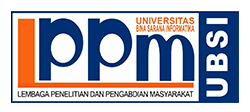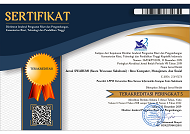PERENCANAAN STRATEGIS SISTEM INFORMASI PERGURUAN TINGGI MENGGUNAKAN METODE WARD & PEPPARD Studi Kasus: STMIK Nusa Mandiri
Abstract
today need to be aligned with the strategy and objectives of the Organization so that the need to set up an outline of the strategic planning of information systems. The three main objectives of the efforts of the application of information system (SI) and information technology (it) within an
organization. The first, repair work efficiency by performing automation processes that manage information. Second, improve the effectiveness of management information in order to satisfy the needs with decision making. Third, improve the competitiveness or enhance the Organization's
competitive advantage by changing style and way of doing business (Ward & amp; Peppard, 2002). The basic concepts used in drawing up the framework for strategic planning of information systems and information technology (SI/TI) at a College is the methodology put forward by John
Ward and Joe Peppard. Framework for strategic planning of information systems and information technology (SI/TI) proposed consists of 5 stages, namely: stage- 1-identification of the Organization, namely the stage-2: analysis of the business environment and information, stage-3
SI/TI target, 4-stage determine strategic SI/TI and stage-5 is a plan and implementation. Analysis of the strategy of using the PESTEL analysis methods, analysis of BCG Matrix, an analysis of Porter's Six Force, SWOT analysis, Value Chain Analysis, analysis of the CSF and the Balanced
Scorecard.The results of the research is creating a framework of planning strategy that integrates TI SI/so it makes it easier for management to manage a resource to generate needed information, accurate, can be used jointly by all the parties.
Full Text:
PDF (Bahasa Indonesia)References
Ellegard, Charlotte. & Grunert, Klaus G. (1992). The Concept of Key Success Factors: Theory and Method. In Baker,Michael. (Ed.). Perspectives on Marketing Management. Chichester:Wiley.
Kaplan, Robert S., & Norton, David P. (1992), January-February). The Balanced Scorecard-Measures That Drive Performance, Harvard Business Review.
Oxford University Press (2009, January). PESTEL analysis of the macroenvironmet. Oxford University Press. January 12, 2010. http://www.oup.com/uk/orc/bin/9780199296378/01student/additional /page_12.htm
Porter, Michael E. (1996, November-December). What is strategy ?. Harvard Business Review.
Porter, Michael E. (1997, August). How competitive Forces Shape Strategy. Harvard Business Review.
Riehle, Dirk. (2007, April). The Economic motivation of open source software:stakeholder perspective. SAP
Research:IEEE Computer Society.
Rochart, J.F. (1979, March-April). Chief Executives Define Their Own Information Needs. In:Harvard Business Review.
The Decision Group (2009, May 15). PEST: Political, Economic, Social, and Technology Analysis. The Decision Group. January 08,2011.
http://www.decide-guide.com/pest/.
Ward, Jhon & Peppard, Joe. (2002). Strategic Planning for Information Systems (3rd ed). West Sussex, England: Jhon Wiley & Sons Ltd.
DOI: https://doi.org/10.31294/swabumi.v1i1.997
INDEXING

P-ISSN : 2355-990X E-ISSN: 2549-5178













